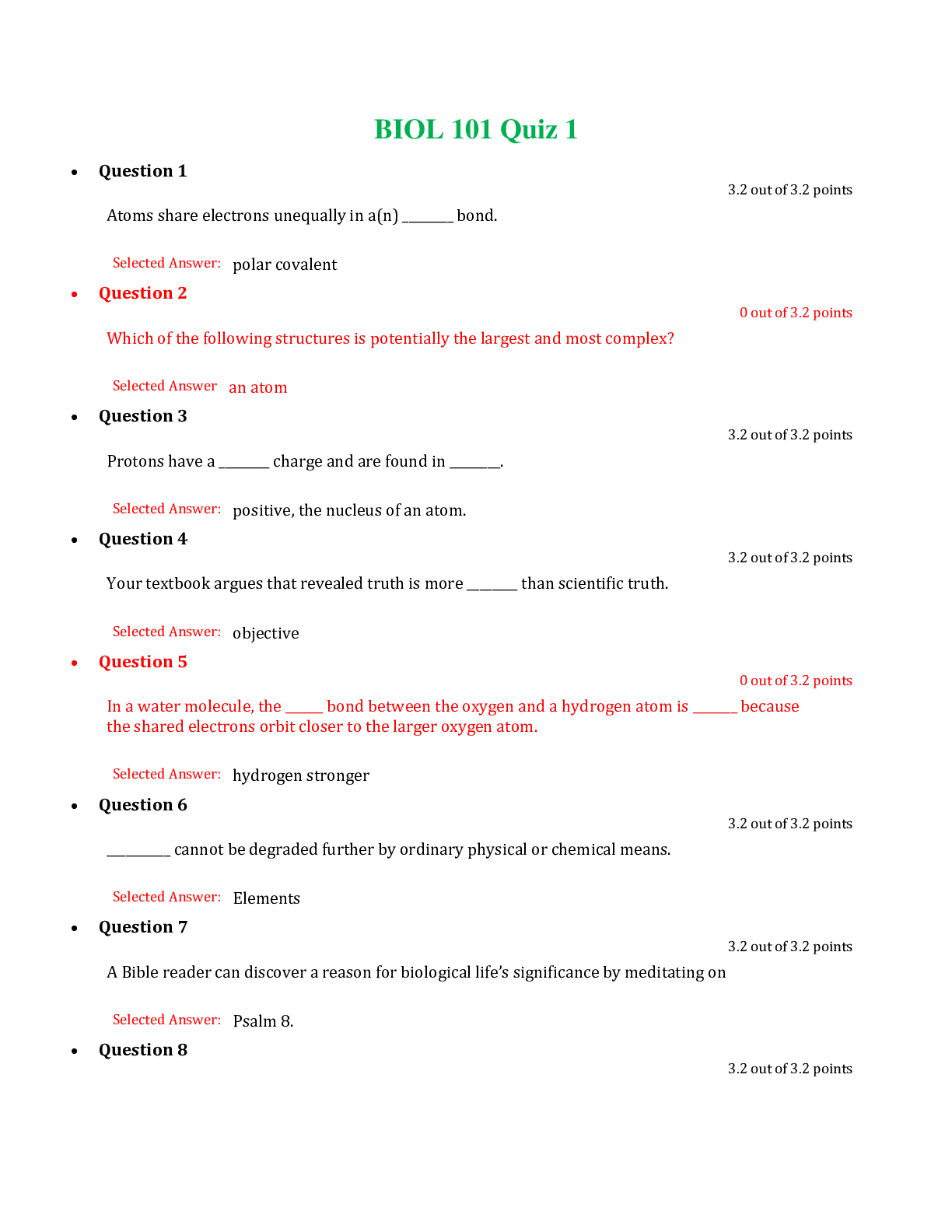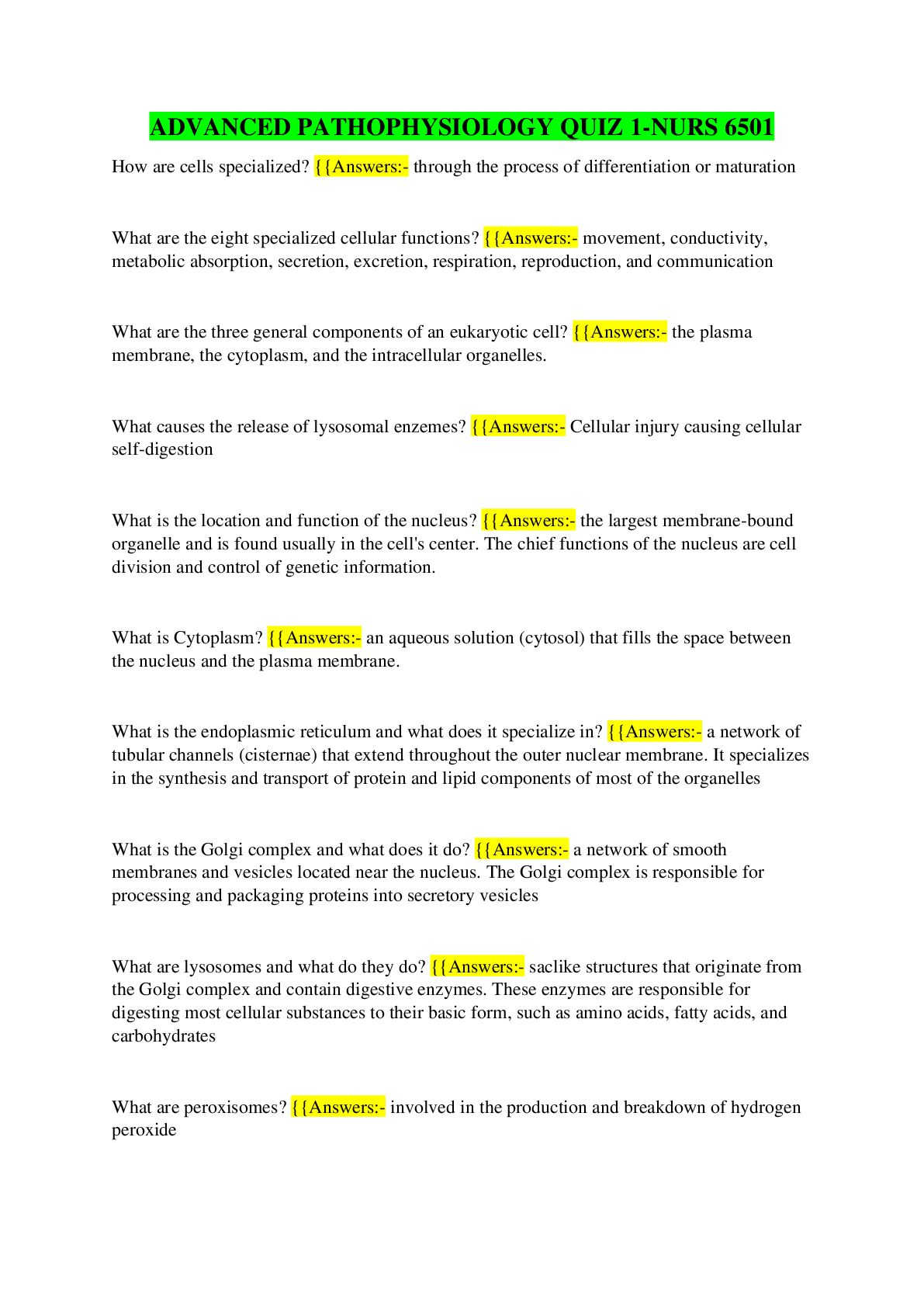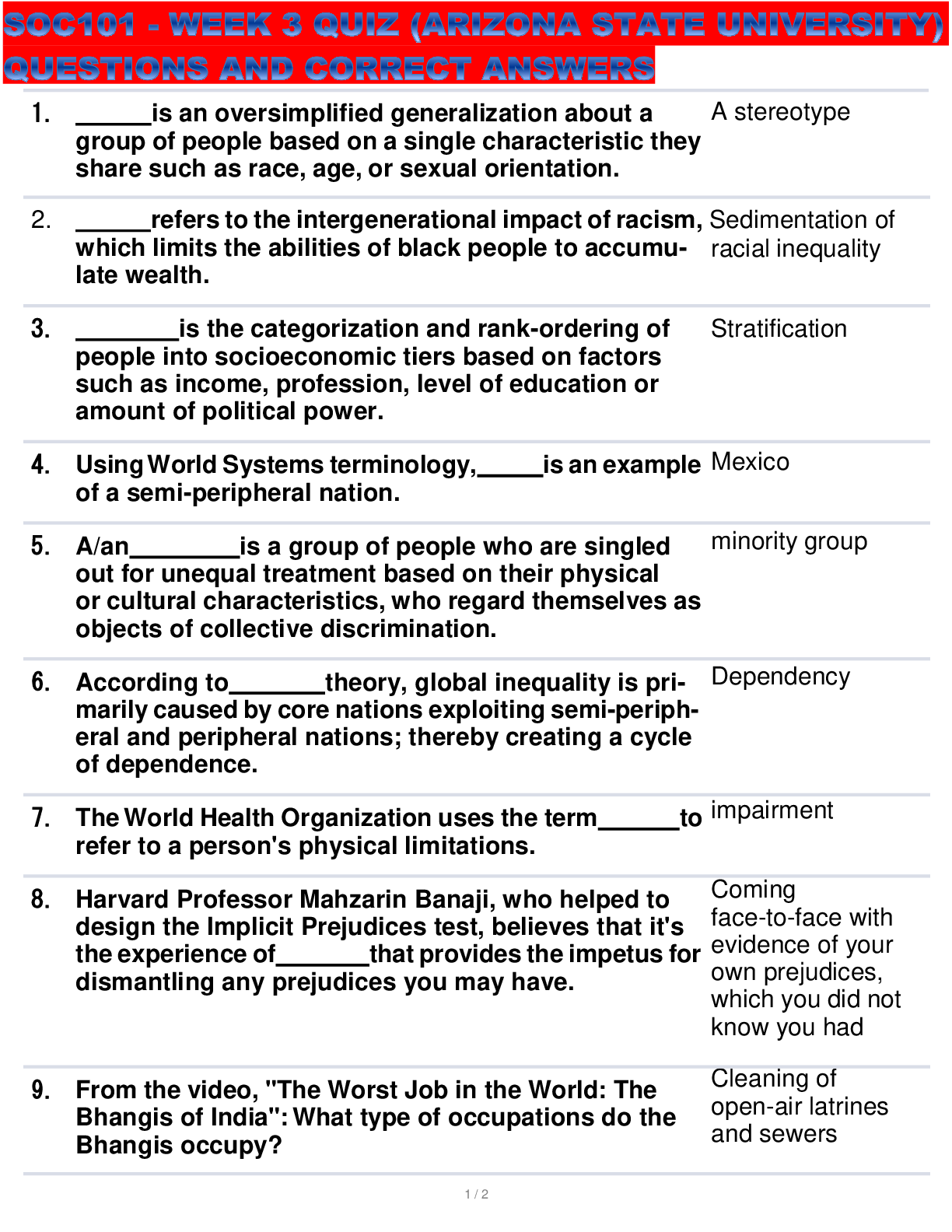Chemistry > EXAM > Organic Chemistry Laboratory (Louisiana Tech University) Questions and Answers: Graded A (All)
Organic Chemistry Laboratory (Louisiana Tech University) Questions and Answers: Graded A
Document Content and Description Below
Answer Key on last page Chapter 27: Pericyclic Reactions 1. Which of the following statements about pericyclic reactions is true? A) Pericyclic reactions occur by way of ionic intermediates. B) Pe ric... yclic reactions occur by way of radical intermediates. C) Pericyclic reactions involve multiple steps. D) Reactive intermediates are not formed in pericyclic reactions. 2. Which of the following statements about pericyclic reactions is true? A) In pericyclic reactions, bonds are broken and formed in multiple steps. B) In pericyclic reactions, all bonds are broken and formed in a single step. C) One intermediate has been identified in pericyclic reactions. D) The transition state in a pericyclic reaction is acyclic. 3. Which of the following statements about pericyclic reactions is not true? A) Pericyclic reactions are concerted reactions. B) Pericyclic reactions proceed through a cyclic transition state. C) Pericyclic reactions are not stereospecific. D) Pericyclic reactions require light or heat. 4. Which of the following is a type of pericyclic reaction? A) electrocyclic reactions C) cycloelimination reactions B) acyclic reactions D) electrophilic reactions 5. Which of the following is not a type of pericyclic reactions? A) cycloadditions C) electrocyclic reactions B) nucleophilic reactions D) sigmatropic rearrangements 6. Which of the following statements about electrocyclic ring closure is not true? A) It is an intramolecular reaction. B) It requires heat or light. C) The cyclic product contains one more bond and one fewer bond than the reactants. D) The cyclic product contains one more bond and one fewer bond than the reactants. 7. Which of the following statements about an electrocyclic ring-opening reaction is not true? A) An electrocyclic ring-opening reaction is an intramolecular reaction. B) An electrocyclic ring-opening reaction requires a source of energy (heat or light). C) The product of an electrocyclic ring-opening reaction contains one fewer bond than the reactant. D) The product of an electrocyclic ring-opening reaction contains one more bond than the reactant. 8. What is the organic product of the following electrocyclic reaction? A) I B) II C) III D) IV 9. Which of the following statements about cycloaddition reactions is true? A) Cycloaddition reactions occur only intermolecularly. B) Cycloaddition reactions occur only intramolecularly. C) Cycloaddition reactions form a cyclic product with two new bonds. D) Cycloaddition reactions can be intramolecular or intermolecular. 10. Which of the following statements about sigmatropic reactions is true? A) The reactants contain one more bond than the product. B) The product contains one more bond than the reactant. C) A bond is broken in the reactant. D) A bond is broken in the reactant. 11. What is the correct classification of the following reaction? A) cycloaddition reaction C) electrophilic reaction B) electrocyclic reaction D) sigmatropic reaction 12. What is the correct classification of the following reaction? A) cycloaddition reaction C) electrophilic reaction B) electrocyclic reaction D) sigmatropic reaction 13. What is the correct classification of the following reaction? A) cycloaddition reaction C) electrocyclic reaction B) electrophilic reaction D) sigmatropic reaction 14. What is the correct classification of the following reaction? A) cycloaddition reaction C) electrocyclic reaction B) electrophilic reaction D) sigmatropic reaction 15. Which of the following statements about orbitals is true? A) orbitals are formed by the linear combination of two sp3 orbitals. B) orbitals are formed by the linear combination of two sp2 orbitals. C) orbitals are formed by the linear combination of two sp orbitals. D) orbitals are formed by the linear combination of two p orbitals. 16. Which of the following statements about molecular orbitals is true? A) The number of molecular orbitals formed is different from the number of atomic orbitals used. Page 3 B) The number of molecular orbitals formed is equal to the number of atomic orbitals used. C) The number of molecular orbitals formed is equal to twice the number of atomic orbitals used. D) The number of molecular orbitals formed is equal to half the number of atomic orbitals used. 17. Which of the following statements about a -bonding molecular orbital is true? A) A -bonding molecular orbital is formed when two p orbitals of similar phase overlap. B) A -bonding molecular orbital is lower in energy than a -bonding molecular orbital. C) A -bonding molecular orbital is formed when two p orbitals of opposite phase overlap. D) Both the statements “a -bonding molecular orbital is formed when two p orbitals of similar phase overlap” and a -bonding molecular orbital is lower in energy than a -bonding molecular orbital” are true. 18. Which of the following statements about a * antibonding molecular orbital is true? A) A * antibonding molecular orbital is formed when two p orbitals of similar phase overlap. B) A * antibonding molecular orbital is formed when two p orbitals of opposite phase overlap. C) A * antibonding molecular orbital is a higher-energy molecular orbital than a bonding molecular orbital. D) Both the statements “a * antibonding molecular orbital is formed when two p orbitals of opposite phase overlap” and “a * antibonding molecular orbital is a higher-energy molecular orbital than a bonding molecular orbital” are true. 19. How many molecular orbitals are present in 1,3,5-hexatriene? A) 3 B) 4 C) 5 D) 6 20. How many bonding molecular orbitals are present in 1,3,5-hexatriene? A) 3 B) 4 C) 5 D) 6 21. How many molecular orbitals are present in 1,3,5,7,9-decapentaene? A) 4 B) 5 C) 10 D) 12 22. How many bonding molecular orbitals are present in 1,3,5,7,9-decapentaene? A) 4 B) 5 C) 10 D) 12 23. How many nodes are present in 5 of 1,3,5,7,9-decapentaene? A) 2 B) 3 C) 4 D) 5 24. Which of the following statements about electrocyclic reactions is true? A) An electrocyclic reaction is generally irreversible. Page 4 Chapter 27: Pericyclic Reactions B) Generally, an acyclic triene is favored over a six-membered ring at equilibrium. C) Generally, a four-membered ring is favored over an acyclic diene at equilibrium. D) An electrocyclic reaction is generally reversible. 25. Predict the major organic product(s) of the following electrocyclic reaction. A) Only I B) Only II C) Only III D) Only I and II 26. Predict the major organic product(s) of the following electrocyclic reaction. A) Only I B) Only II C) Only III D) Only I and II 27. Predict the major organic product(s) of the following electrocyclic reaction. A) Only I B) Only II C) Only III D) Only I and II Page 5 Chapter 27: Pericyclic Reactions 28. Predict the major organic product(s) of the following electrocyclic reaction. A) Only I B) Only II C) Only III D) Only I and II 29. Which of the following statements about thermal electrocyclic reactions is not true? A) The number of bonds in the conjugated polyene determines whether rotation is conrotatory or disrotatory. B) Thermal electrocyclic reactions occur in a disrotatory fashion for a conjugated polyene with an odd number of bonds. C) Thermal electrocyclic reactions occur in a conrotatory fashion for a conjugated polyene with an even number of bonds. D) In thermal reactions, we consider the orbitals of the HOMO of the ground state electronic configuration to determine the course of the reaction. 30. Which of the following statements about photochemical electrocyclic reactions is not true? A) In photochemical reactions, we consider the orbitals of the HOMO of the excited state to determine the course of the reaction. B) Photochemical electrocyclic reactions occur in a conrotatory fashion for a conjugated polyene with an odd number of bonds. C) Photochemical electrocyclic reactions occur in a disrotatory fashion for a conjugated polyene with an even number of bonds. D) In photochemical reactions, we consider the orbitals of the LUMO of the excited state to determine the course of the reaction. 31. Which of the following statements about cycloaddition reactions is not true? A) Cycloaddition reactions form a cyclic product with two new bonds. B) The course of the reaction is determined by the symmetry of the molecular orbitals of the products. C) Cycloaddition reactions are concerted. D) Cycloaddition reactions are stereospecific. 32. Which of the following statements about cycloaddition reactions is true? A) Cycloaddition reactions can be initiated by heat only. Page 6 Chapter 27: Pericyclic Reactions B) Cycloaddition reactions can be initiated by light only. C) Cycloaddition reactions can be initiated by heat or light. D) Cycloaddition reactions are identified by the number of electrons in the two products. 33. Why is the Diels-Alder reaction called a thermal [4 2] cycloaddition? A) Because the reaction is initiated by heat; the diene has four electrons and the dienophile has two electrons. B) Because the reaction is initiated by light; the diene has four electrons and the dienophile has two electrons. C) Because the reaction is initiated by heat; the dienophile has four electrons and the diene has two electrons. D) Because the reaction is initiated by light; the dienophile has four electrons and the diene has two electrons. 34. Which of the following statements about [2 2] cycloaddition reactions between two alkenes is true? A) The reaction is initiated by heat. B) The reaction is initiated by light. C) The product is a cyclopentane derivative. D) Each reactant contains two electrons that participate in the formation of new bonds. 35. What type of cycloaddition reaction is shown below? A) [2 2] B) [4 2] C) [4 4] D) [0 2] 36. What type of cycloaddition reaction is shown in the following equation? A) [2 2] B) [4 2] C) [4 4] D) [0 2] 37. What are the two modes of bond formation in cycloaddition reactions? A) suprafacial and antarafacial bond formations. B) superfacial and antifacial bond formations. C) suprafacial and synfacial bond formations. Page 7 Chapter 27: Pericyclic Reactions D) synfacial and antifacial bond formations. 38. Which of the following statements about orbital symmetry and cycloaddition reactions is true? A) Thermal cycloadditions involving an even number of bonds proceed by a suprafacial pathway. B) Thermal cycloadditions involving an odd number of bonds proceed by a suprafacial pathway. C) Photochemical cycloadditions involving an odd number of bonds proceed by a suprafacial pathway. D) Photochemical sycloadditions involving an even number of bonds proceed by an antarafacial pathway. 39. Which of the following statements about orbital symmetry and cycloaddition reactions is true? A) Thermal cycloadditions involving an even number of bonds proceed by a suprafacial pathway. B) Thermal cycloaddition involving an odd number of bonds proceed by an antarafacial pathway. C) Photochemical cycloadditions involving an even number of bonds proceed by an antarafacial pathway. D) Photochemical cycloadditions involving an even number of bonds proceed by a suprafacial pathway. 40. Which of the following statements about sigmatropic reactions is not true? A) A sigmatropic reaction is an intramolecular pericyclic reaction. B) In a sigmatropic reaction, bond is broken in one of the reactants. C) The bonds rearrange in a sigmatropic reaction. D) The number of bonds in the reactants and product differs in a sigmatropic reaction. 41. Which of the following is not a correct designation for a sigmatropic rearrangement? A) [1,3] B) [1,5] C) [3,3] D) [3,1] 42. What type of sigmatropic rearrangement is illustrated below? A) [1,3] B) [1,4] C) [3,3] D) [1,5] Page 8 Chapter 27: Pericyclic Reactions 43. What type of sigmatropic rearrangement is illustrated below? A) [1,3] B) [1,4] C) [3,3] D) [1,5] 44. What type of sigmatropic rearrangement is illustrated below? A) [1,3] B) [1,4] C) [3,3] D) [1,5] 45. Which of the following statements about sigmatropic rearrangements and orbital symmetry is not true? A) Reactions involving six atoms or fewer must take place by suprafacial pathways. B) In a suprafacial rearrangement, the new bond forms on the opposite side of the system as the broken bond. C) In an antarafacial rearrangement, the new bond forms on the opposite side of the system as the broken bond. D) In a suprafacial rearrangement, the new bond forms on the same side of the system as the broken bond. 46. Which of the following statements about the Cope rearrangement is not true? A) The Cope rearrangement involves the rearrangement of a 1,5-diene to an isomeric 1,5-diene. B) The Cope rearrangement takes place readily in a suprafacial pathway under photochemical conditions. C) The Cope rearrangement involves three electron pairs; two in bonds and one in a bond. D) The Cope rearrangement takes place readily in a suprafacial pathway, when heated. 47. Which of the following statements about the Claisen rearrangement is true? A) The Claisen rearrangement occurs readily in a suprafacial pathway under photochemical conditions. B) The Claisen rearrangement occurs readily in an antarafacial pathway under thermal conditions. C) The Claisen rearrangement involves three electron pairs; two in bonds and one in a bond. D) The Claisen rearrangement involves the rearrangement of an unsaturated ether to a ,-unsaturated carbonyl compound. Page 9 Chapter 27: Pericyclic Reactions 48. What is the major organic product of the following Cope rearrangement? A) I B) II C) III D) IV 49. What is the major organic product of the following oxy-Cope rearrangement? A) I B) II C) III D) IV 50. What is the major organic product of the following Claisen rearrangement? A) I B) II C) III D) IV Page 10 Chapter 27: Pericyclic Reactions 51. What is the major organic product of the following Claisen rearrangement? A) I B) II C) III D) IV 52. Which of the following statements about a thermal reaction involving an even number of electron pairs is true? A) A thermal reaction involving an even number of electron pairs is conrotatory or antarafacial B) A thermal reaction involving an even number of electron pairs is disrotatory or suprafacial C) A thermal reaction involving an even number of electron pairs is conrotatory or suprafacial D) A thermal reaction involving an even number of electron pairs is disrotatory or antarafacial Chapter 27: Pericyclic Reactions Answer Key [Show More]
Last updated: 2 years ago
Preview 1 out of 3 pages

Buy this document to get the full access instantly
Instant Download Access after purchase
Buy NowInstant download
We Accept:

Reviews( 0 )
$14.00
Can't find what you want? Try our AI powered Search
Document information
Connected school, study & course
About the document
Uploaded On
May 01, 2020
Number of pages
3
Written in
Additional information
This document has been written for:
Uploaded
May 01, 2020
Downloads
0
Views
111



















